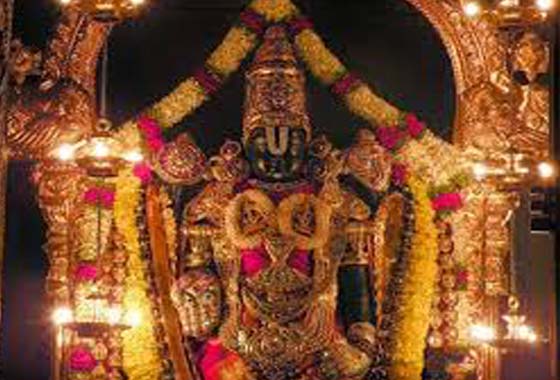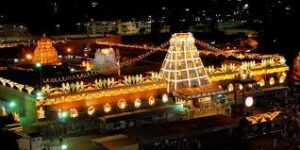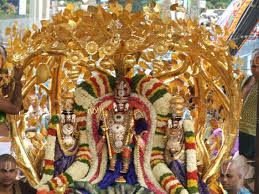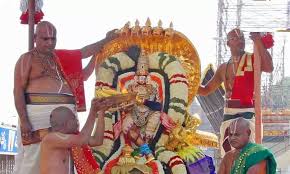
Lord Sree Venkateshwara Swamy Brahmotsavas Fete
DVS Reddy
(Editor-In-Chief)
Tirumala Hills are echoes with the chanting of “Om Namo Venkateshaya”, “Om Namo Tirumalesha”, “Om Namo Srinivasa” etc., the names of Lord Sree Venkateshwara. The devotees of Lord Sree Venkateshwara chanting the Mantras with devotion in the Brahmotsavas every year in Tirumala.

TTD decorated Tirumala Balaji Temple and streets with lights and flowers for the annual Brahmotsavas of Lord Sree Venkateshwara. The Brahmotsavas starts with “Ankurarpana” on Sept 18, 2020, in the Mithuna Lagnam.

Sree Venkateshwara Swamy Vaari Brahmotsavams will celebrate according to the Hindu Lunar Calendar, month of “Ashwayuja,” which falls between the “Gregorian Calendar” months of September and October. The Utsava-murti (processional deity) of the presiding deity, Venkateswara, and his consorts Sridevi and Bhudevi are taken on a procession on several vahanams on the streets surrounding the temple. The celebration attracts pilgrims and tourists from all over India and around the world. A Brahmotsavams is a cleansing ceremony in honor of Lord Brahma, and the ceremony at Tirumala is the largest
When there is an extra month in the lunar calendar, two Brahmotsavam are held: Salakatla and Navarathri. Both festivals were held in 2015 and 2018. In Salakatla Brahmotsavam, Rathotsavam (Big Chariot) is held on the morning of the eighth day; during Navratri Brahmotsavam, Golden Chariot (Swarna Rathotsavam) is held that morning of the eighth day. In Salakatla Brahmotsavam, there is a flag-lowering (Dwajaavarohanam) on the evening of the ninth day.
The first reference to festivals in the Tirumala Venkateswara Temple was in 966 CE, when the Pallava queen Samavai endowed land and ordered its revenue to celebrate festivals in the temple. Until 1582, Brahmotsavams were held as often as 12 times a year. According to the legend of Tirumala, Brahma descends to earth to conduct the festival. Sri Venkteswara Sahasranamastotra refers to Brahma performing the festival, signified by a small, empty wooden chariot (brahmaratham) which moves ahead of the processions of the Venkateswara processional deity Malayappa.

The Brahmotsavam is held over nine days at the beginning of the Hindu calendar month of Ashwayuja, paralleling Navaratri. The evening before the first day, the rite of Ankurarpana (the sowing of seeds to signify fertility and abundance) is performed. The main first-day activity is Dwajarohana, the raising of the Garuda flag to signify the beginning of the festival. Religious activities during the festival include daily homas and processions on streets surrounding the temple. The final day commemorates Venkateswara’s birth star. The Sudarshana Chakra is bathed in the temple tank with the devotees. The Chakra is then placed on a high platform, and the devotees walk under it and are blessed with its dripping water. The festival ends with Dhvajavarohanam, the lowering of the Garuda flag.
Dwajarohanam
A ceremony on the first day, when a flag with a picture of Garuda (the vehicle of Vishnu) is hoisted over the temple. The flag is believed to be a symbolic invitation to the Hindu deities to attend the festival. After the ceremony, the Andhra Pradesh chief minister offers new silk clothes to Venkateswara.
Garuda Vahanam
On the evening of the fifth day, Venkateswara and Garuda are carried in a procession and decorated with garlands of flowers. Every year, the Tirupati Venkateswara garland is sent to the Srivilliputtur Andal Temple for the marriage festival of Andal.
Hanumantha Vahanam
On the morning of the sixth day morning, Venkateswara and Hanuman are taken out in procession.
Chakra Snanam
On the morning of the ninth day, the Malayappa, his two consorts and the Sudarshana Chakra are carried in procession to the Varahaswamy Temple. After the abhishekam and presentation of food offerings, the Sudarshana Chakra and its devotees are bathed in the temple tank.